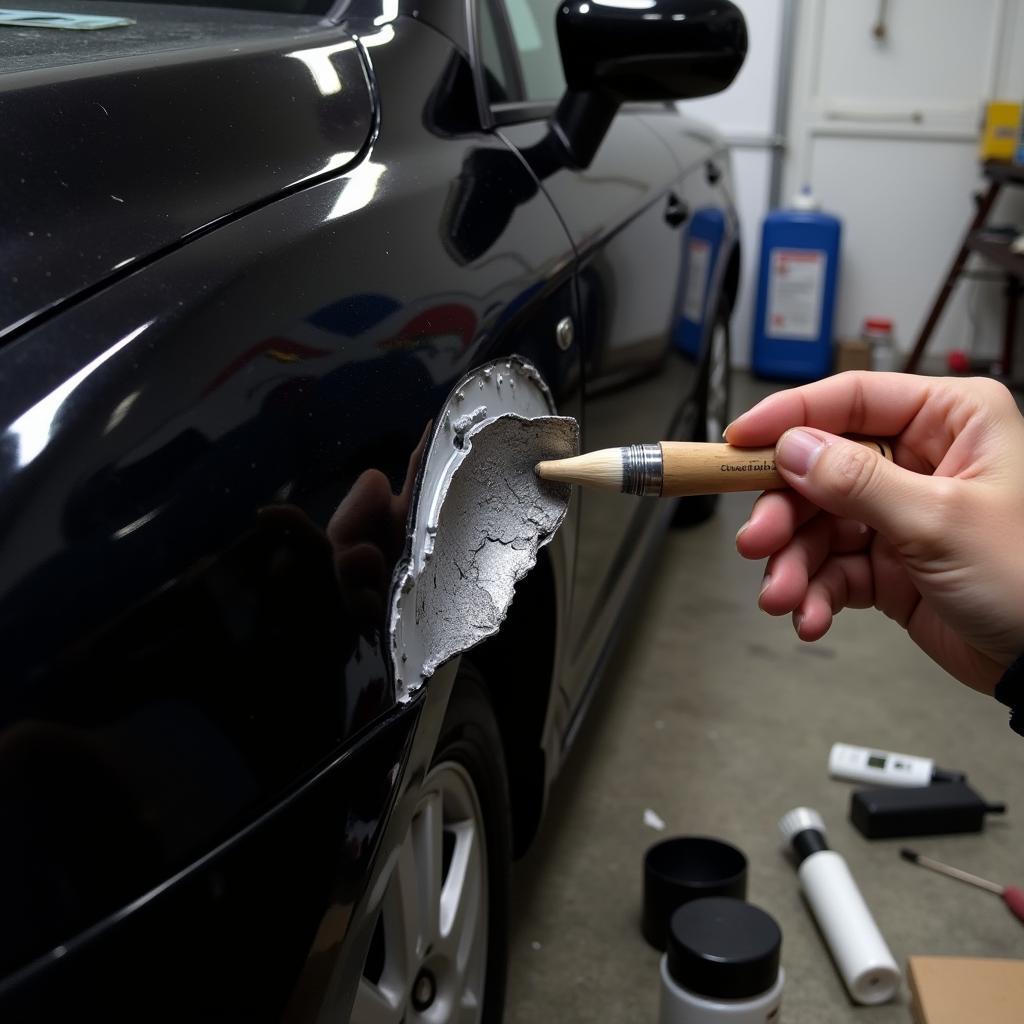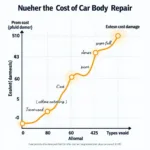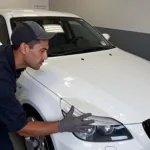Fixing paint chips on a black car can seem daunting, as the dark color makes imperfections stand out. However, with the right approach and a little patience, you can achieve professional-looking results and protect your car’s finish. This guide provides a comprehensive step-by-step process to effectively repair those pesky paint chips.
Repairing minor paint chips yourself can save you significant money compared to a professional repair. It also helps prevent further damage like rust, which can be costly down the road. For more complex paint repairs, consider resources like orem car paint repair.
Assessing the Damage: Types of Paint Chips
Before starting the repair, it’s crucial to assess the extent of the damage. Chips can range from minor surface scratches to deeper gouges that expose the metal underneath. Understanding the type of chip will determine the appropriate repair method.
Identifying Surface Scratches
Surface scratches are the easiest to fix. They only affect the clear coat and don’t penetrate the color coat. These can often be buffed out with polishing compound.
Dealing with Deep Chips
Deeper chips expose the base coat or even the metal underneath. These require more attention and may involve filling the chip with touch-up paint. If you are unsure about handling this yourself, a car paint scratch repair specialist can provide expert assistance.
Gathering Your Supplies for Black Car Paint Repair
Having the right tools and materials is essential for a successful repair. Here’s what you’ll need:
- Touch-up paint (perfectly matched to your car’s color code)
- Primer (if the chip goes down to the metal)
- Fine-grit sandpaper (2000-3000 grit)
- Rubbing compound
- Polishing compound
- Wax
- Microfiber cloths
- Masking tape
- Applicators (toothpicks, brushes, or touch-up pens)
For a quick and easy solution to minor scratches, you can explore options like a car auto coat scratch clear repair paint pen.
How to Repair the Paint Chip: A Step-by-Step Guide
Once you’ve gathered your supplies, follow these steps carefully to repair the paint chips on your black car:
- Clean the Area: Thoroughly wash and dry the area around the chip to remove any dirt or debris.
- Mask the Surrounding Area: Use masking tape to protect the paint around the chip. This will prevent accidental scratching during the sanding and polishing process. Learn more about specific black car paint repairs at black paint repair car.
- Sand (If Necessary): If the chip is rough or has raised edges, carefully sand the area with fine-grit sandpaper until smooth. Be gentle to avoid removing too much paint.
- Apply Primer (If Necessary): If the chip reaches the metal, apply a thin coat of primer to prevent rust. Let it dry completely.
- Apply Touch-Up Paint: Using a toothpick, brush, or touch-up pen, carefully apply thin layers of touch-up paint to the chip. Allow each layer to dry before applying the next. Avoid applying too much paint at once, as it can lead to bubbling or an uneven finish. Consider using techniques mentioned in guides like how to car touch up paint repair.
- Sand and Polish: Once the touch-up paint is dry, carefully sand the area with fine-grit sandpaper to level it with the surrounding paint. Follow up with rubbing compound and polishing compound to restore the shine.
- Wax: Apply a layer of wax to the repaired area to protect it and enhance the shine.
Preventing Future Paint Chips
Protecting your car’s paint from future chips is key to maintaining its appearance. Consider these preventive measures:
- Regular Washing and Waxing: This helps protect the paint from environmental contaminants and UV rays.
- Parking Carefully: Avoid parking too close to other cars or in areas with low-hanging branches.
- Using Paint Protection Film: This clear film can be applied to vulnerable areas to protect them from chips and scratches.
Conclusion
Repairing paint chips on a black car requires patience and attention to detail, but it’s a manageable DIY project that can save you money and preserve your car’s appearance. By following the steps outlined in this guide and taking preventive measures, you can keep your black car looking its best for years to come. Remember, addressing even minor chips promptly helps prevent further damage like rust and keeps your car looking pristine. Addressing paint chips effectively is crucial to maintaining your vehicle’s appearance and value.
FAQs
- What if the touch-up paint doesn’t perfectly match my car’s color? Slight variations in color can occur. Consult a professional for perfect color matching.
- Can I use any type of touch-up paint? No, it’s essential to use touch-up paint specifically designed for your car’s make and model.
- How long does the repair process take? It can take a few hours to a day, depending on the size and depth of the chip and drying times.
- What if the chip is too large to repair myself? For large or complex chips, consult a professional auto body shop.
- How can I prevent paint chips in the future? Regular washing and waxing, careful parking, and paint protection film can help prevent future chips.
- Do I need to apply a clear coat after the touch-up paint? Some touch-up paints include a clear coat. Check the product instructions.
- What type of sandpaper should I use for sanding the touch-up paint? Use very fine-grit sandpaper (2000-3000 grit) to avoid scratching the surrounding paint.
Common Paint Chip Scenarios
- Rock Chips on the Hood: These are common due to debris kicked up by other vehicles.
- Door Edge Chips: These often occur from opening doors into tight spaces.
- Bumper Scrapes: Parking lot bumps and minor collisions can cause bumper scrapes.
Further Assistance
For more information on car repair topics, consider exploring our other helpful resources.
Need help with car repair? Contact us via WhatsApp: +1(641)206-8880 or Email: [email protected]. Our 24/7 customer support team is here to assist you.



